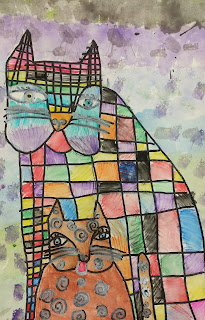Fifth Grade Art
6 to 7
Class Periods
Day 1
This is one of my favorite lessons that I do with my middle school students. On day one of this lesson we go over a small booklet that I made for the students on the different types of dragons. Students are fascinated to learn about all the different types of dragons.
Dragon Types
Western Dragons: The Western Dragon has a thick, long body. It has scaly skin, four strong legs and two bat-like wings. It has a very long neck and a wedge shaped head. There tails can be spiked or have a spade on the tip of it. This type of dragon is fire breathing. Some of these types of dragons have been known to change shapes or have the power to change their color to match their environment like a chameleon.
Eastern Dragons: Eastern Dragons are known as being good, kind and intelligent. They have a snake-like body, four legs and do not breath fire or have wings. Most of the time, they are shown to have a lion-type mane around its neck, on its chin and on each elbow. They have two antler type horns on top of their head and two long "feeler" whiskers spreading out from their snout. Eastern Dragons can be blue, black, white, red or yellow. They are usually drawn with a pearl in their mouth, under their chin or in their claws. The pearl is the dragon's power source.
Faerie Dragons: Faerie Dragons are very small, can be any color with large eyes and large butterfly wings. These dragons are vegetarians are the rarest of all dragons. In legend they are known to carry faeries from city to city.
Hydra: A Hydra is a dragon that has multiple neck and heads (usually 6 to 9). They may or may not have wings or legs.
Sea Serpent: The Sea Serpent is a dragon that lives in fresh or salt water. The most famous sea serpent is "Nessie" the Loch Ness Monster in Scotland.
Day 2
Students are given a piece of 12 x 18 inch piece of watercolor paper. Using a ruler, students created a border around their composition.
Next, I provided students tips with how to begin their dragon drawing. I recommended for students to being with a lightly drawn "S" shape. As students began to draw, I informed them that part of their dragon or an object that is drawn in their background must go into the border of the composition.
Day 3
Students continue to work on drawing their dragon and background details. We discuss implied textures on this day and through demonstration give students ideas on how to draw texture in their composition. I require that each student draw at least one implied texture to their drawing. Some examples that I share with the students are scales on the dragon, brickwork on a castle, or patterns within the border. When all the pencil drawing is in place, we outline with a sharpie marker.
Day 4
During this class period, I teach students several watercolor techniques. I demonstrate the following resist methods: saran wrap, rice, salt and crayon. I also demonstrate how to create an opaque or transparent look with the watercolor paint. The final technique I teach students is the blot method. As I demonstrate each method, I give students ideas on how they can use the method in their painting. Blot technique can be used to create clouds or smoke from the dragon's nostrils. Crayon resist is wonderful for keeping toe nails, teeth and eyes white. Saran wrap makes a beautiful water effect. The list goes on and on. The rest of the class period is used for practicing the techniques.
Day 5, 6 & 7
The last days of the lesson are used for painting. Students are taught to work from the background to the foreground. Tips are given on how to watch out for colors bleeding together. Proper brush size is addressed. Students are required to use at least three watercolor techniques in their painting. Once the painting is completed and the paint is dry, students go over any areas with sharpie marker that may have gotten lost in the painting process.
 |
| Painting the dragon. |
Examples of Student Work





























































